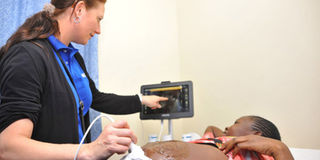Boy or girl? Slum mothers savour scanning magic

PHOTO | VERAH OKEYO A pregnant mother watches as Philips’ Business Development Officer Ulrich Klaus shows her features of her developing baby on an ultrasound monitor at a health centre in Kibera. The company screened the women for free.
What you need to know:
- Ultrasound scans are out of reach for expectant women in informal settlements and rural areas
Juliana Kavula sat patiently on the queue waiting for her turn.
This was the second time in two weeks she had walked into the Amref medical centre in Kibera, Nairobi, for her date with the radiographer and the queue was still as long as it had been the last time she visited.
From a quick glance, there were 40 to 50 women who had to be served before her turn, but she was very hopeful. And so, together with the rest of the pregnant women who had queued from as early as 6 a.m., she sat and waited.
“I want to see for myself how the baby looks like in my womb,” she told the Sunday Nation on Thursday.
“The health worker told me that I would be able to see the foetal formation and I hardly slept last night because the feeling is so overwhelming,” she said animatedly before going back to a conversation with two women who sat on either side about the gender they preferred for their babies.
In a different room across a hallway, Vicky Koi, a radiographer, was taking the women through the steps of an ultrasound scan.
“Would you like to know the sex of your baby?” she asked an excited Josephine Itenyo who lay on the examination table.
In the waiting room, Josephine had told the Sunday Nation that she was hoping for a girl because her other two children are boys and this was her last pregnancy. She was nonetheless happy to know that she was carrying another boy.
Electronic company Philips, which recently unveiled Visiq -- a portable hand-held ultrasound scanner in Kenya -- has been performing free ultrasound scans in the Kibera slums. Being a first-time experience for Kibera women, the numbers were overwhelming.
The device, which is the size of a computer tablet, uses smart phone technology. Unlike the conventional scanners which require pregnant mothers to visit a hospital, the portable device is appropriate for expectant mothers in slums and rural areas who otherwise do not obtain antenatal services in hospitals.
“There is a growing global focus on cost-effective systems, smaller footprints and imaging equipment which are easy to operate and have improved clinical functionality,” said Peter van de Ven, Vice- President and General Manager, Philips Healthcare Africa.
Mr de Ven said the gadget can also be used in community care programmes in remote rural areas for screening, triage and foetal well-being scans, all of which help to address the critical issue of maternal and infant care in Kenya.
Small outpatient clinics or community centres can also carry out comprehensive abdominal scans without referring patients to hospitals.
“Poor women can also get the chance of knowing in advance whether they would deliver normally or they would need a Caesarean section and plan for it rather than know when they are already in labour,” said Koi.
According to Lydia Kuria, a project officer at Amref who runs an antenatal clinic in the slum, most women cannot afford foetal well-being scans.
“For health facilities in the slums, an ultrasound is not a routine check-up because the women can’t pay for the service,” she said.
An ultrasound at a public health facility costs Sh2,000 which is thrice the amount of money that most families in Kibera spend on rent.
“If you go for an ultrasound at least once during pregnancy, you can detect any complication before the mother goes into labour because, by then, it may be too late,” she said.
“With abdominal checks like the ones most health officers use to check for pregnancy, you cannot tell the position of the placenta and the only time you will get to know is when the woman starts bleeding,” she said.
BREACH POSITION
Last year she attended to a woman who was brought into the facility in labour at night and the baby was in a breach position. They managed to save the mother but the baby did not make it. She says such a scenario could have been avoided if the mother had gone for an ultrasound scan.
According to the World Health Organisation (WHO), diagnostic imaging is crucial in healthcare. However, many in the developing world cannot afford high technology imaging equipment despite the urgent need.
In Kenya, the harsh reality of this worrying scenario manifests itself in the large number of maternal deaths. According to the Kenya Demographic Survey 2009, it is estimated that 7,700 women die each year from pregnancy-related complications. This translates to 21 women dying each day or one woman every hour from preventable causes.
The survey also estimates that there are an average 488 deaths per 100,000 live births in the country.





